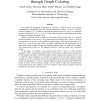Free Online Productivity Tools
i2Speak
i2Symbol
i2OCR
iTex2Img
iWeb2Print
iWeb2Shot
i2Type
iPdf2Split
iPdf2Merge
i2Bopomofo
i2Arabic
i2Style
i2Image
i2PDF
iLatex2Rtf
Sci2ools
DCC
2007
IEEE
2007
IEEE
Distributed Functional Compression through Graph Coloring
We consider the distributed computation of a function of random sources with minimal communication. Specifically, given two discrete memoryless sources, X and Y , a receiver wishes to compute f(X, Y ) based on (encoded) information sent from X and Y in a distributed manner. A special case, f(X, Y ) = (X, Y ), is the classical question of distributed source coding considered by Slepian and Wolf (1973). Orlitsky and Roche (2001) considered a somewhat restricted setup when Y is available as side information at the receiver. They characterized the minimal rate at which X needs to transmit data to the receiver as the conditional graph entropy of the characteristic graph of X based on f. In our recent work (2006), we further established that this minimal rate can be achieved by means of graph coloring and distributed source coding (e.g. Slepian-Wolf coding). This characterization allows for the separation between "function coding" and "correlation coding." In this paper,...
| Added | 25 Dec 2009 |
| Updated | 25 Dec 2009 |
| Type | Conference |
| Year | 2007 |
| Where | DCC |
| Authors | Devavrat Shah, Muriel Médard, Sidharth Jaggi, Vishal Doshi |
Comments (0)

